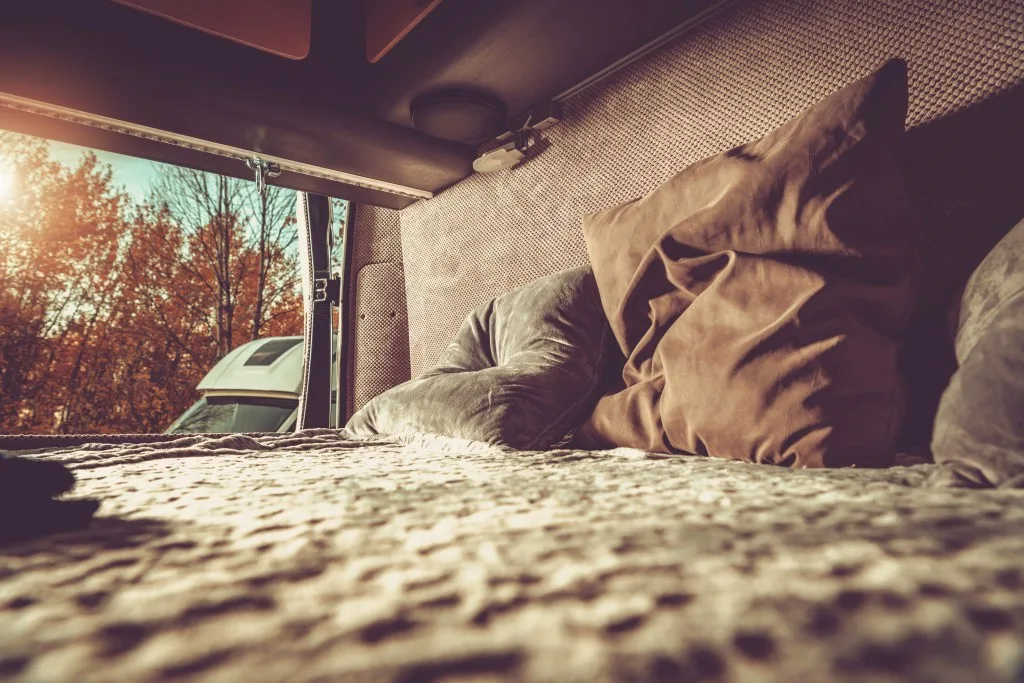Many people have a love-hate relationship with winter. Some love the beauty of a landscape lying under a fresh blanket of snow. However beautiful as it may be, the freezing temperatures accompanying the snow can often be unbearable.
If you enjoy winter camping in an RV, staying warm can feel like an impossible task. You may want to turn to your favorite heated blanket to keep you warm during these times.
But should you use a heated blanket in your RV overnight? Let’s look and see!
What Is a Heated Blanket?
Heated blankets generate heat in wires that run throughout a blanket. They require an electrical source to create the heat but can be very effective ways to keep comfortable and warm during colder temperatures. You can use them as lap blankets while lounging on the couch or in a chair.
One of the best applications of a heated blanket is to place it as the base layer of your bedding. If you’re worried about staying warm while you sleep, flip on your heated blanket when you start your nightly sleeping routine.
Give the blanket 15 to 30 minutes to work, and you’ll climb into a highly toasty bed and likely have no trouble staying warm throughout the night.
How Many Watts Does a Heated Blanket Use?
Heated blankets do not use much electricity. A standard heated blanket will require approximately 150 to 200 watts per hour. For those unfamiliar with electricity, this is a very minimal power draw.
While costs will vary by your local electrical rates, the approximate cost to run a heated blanket for 10 hours would be 15 to 30 cents. Considering the benefit you receive from a heated blanket, it’s a price worth paying!
And, based on your RV battery system & overall power needs, you can figure out if your battery system will have enough power with the numbers.

Are Heated Blankets Safe?
There are likely minimal safety risks if you have a modern heated blanket. However, you should check to ensure no recalls exist or that there aren’t any safety issues specific to your heated blanket model.
You generally have nothing to worry about regarding safety while using modern heated blankets.
However, safety has come a long way since heated blankets started hitting the market decades ago. Some heated blankets are decades old and somehow still keep on working. Using a heated blanket past its prime and operating on borrowed time can be dangerous. Malfunctions can occur that could pose a risk of electrocution or fire.
Some users have experienced severe burns from their heated blankets. There is a risk of overheating, and pregnant women should talk with their medical professional before snuggling under a heated blanket.
Pro Tip: Stay warm this winter by using our guide on How to Prep Your RV for Cold Weather.
Should You Use a Heated Blanket in Your RV Overnight?
While modern heated blankets have better safety features, manufacturers generally discourage users from using heated blankets overnight. While the risks of a fire or other potentially hazardous situations are slim, it’s not a risk worth taking. Fires in an RV can spread very quickly, and an entire RV can burn to the ground in minutes.
The more acceptable use of a heated blanket in an RV is only to use it while you’re awake.
If you’re placing it in your bed, turn it on and let it warm your bed before crawling into it. However, you should turn it off once you’ve climbed into bed.

Tips for Staying Warm in Your RV
Staying warm in your RV can be challenging during the winter, but not impossible. Here are a few tips to help you stay warm (and safe) in your RV. Let’s get started!
Always Keep a Supply of Propane
Your RV furnace will need propane to heat your rig. If your RV has multiple propane bottles, you should only open one at a time. You may wake up to a cold RV. However, you can quickly open the other propane bottle, and you’ll have heat in no time. You can then take the empty bottle to the nearest fill station and avoid being entirely out of propane.
If you open both bottles simultaneously, you may not know you’re running low on propane until it’s too late. With temperatures dropping at night, you’re more likely to run out of propane in the middle of the night when the fill station closes. It could make for a long and cold night while you wait for the fill station to open.
Use Space Heaters Wisely (or not at all)
Space heaters can be an excellent way to create a tremendous amount of heat. However, they require a high amount of power. Running multiple space heaters in your RV can cause you to trip the breaker on your power pedestal or overload your RV’s electrical system.
If you have any damaged wiring, this can quickly create a hazardous situation. A faulty electrical system could generate a tremendous amount of heat and cause a fire to break out behind walls or in the underbelly of your RV. When you’re aware of the issue, it could take a minute or two to gather whatever you can and find safety outside your RV.
Pro Tip: Keep your toes toasted and fingers unfrosted by using these 5 Ways to Heat Your RV This Winter.
Dress in Layers
If it’s winter, you need to dress like it. This means you’ll probably be unable to walk around inside your RV in shorts and a t-shirt if you want to stay comfortable.
Dressing in layers can help you stay warm and adjust as you go about life in your rig. It can also be helpful to invest in a quality pair of socks to keep your feet warm.

Buy a Four-Season RV
Not all RVs can withstand cold weather. Four-season RVs often provide the most help regarding staying comfortable in your RV. These rigs typically have better-quality construction and more insulation.
They also commonly feature cold-weather features like tank heaters, heat-ducted storage compartments, and an enclosed underbelly. These can help ensure you stay warm in freezing temperatures.
Upgrade Insulation Where Necessary
Some RV manufacturers will get skimpy when placing insulation. If you’re feeling a draft, the air may get in from the outside. You’ll want to investigate where it’s coming in and beef up the insulation in that area.
Outdoor kitchens may be convenient for cooking and preparing meals, but they are a common source of letting in cold air. Make sure your manufacturer has provided a sufficient amount of insulation in this area.
Stay Warm and Be Safe in Your RV
You can stay warm and safe while RVing in the winter. Using a heated blanket can be helpful, but you must be mindful of the potential dangers. Despite minimal risk with modern heated blankets, we still encourage you to use them wisely. You can easily avoid dangerous situations if you take the proper precautions. Stay safe and warm while RVing!
Are you planning on going on any adventures in your RV this winter? Tell us where in the comments!
Discover the Best Free Camping Across the USA
To be honest with you, we hate paying for camping. There are so many free campsites in America (with complete privacy).
You should give it a try!
As a matter of fact, these free campsites are yours. Every time you pay federal taxes, you’re contributing to these lands.
Become a FREE CAMPING INSIDER and join the 100,000 campers that love to score the best site!
We’ll send you the 50 Best Free Campsites in the USA (one per state). Access the list by submitting your email below: